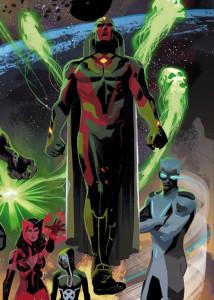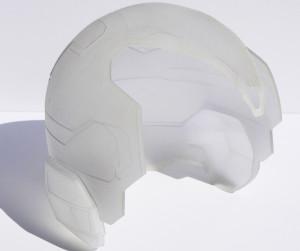As one of the highest grossing films of all time it is a pretty safe bet that the Marvel Studios’ latest film, Avengers: Age of Ultron, did something right. There were certainly plenty of notable moments and new characters in the film, but there was almost universal praise for the Vision, the newest Avenger played by Paul Bettany. Acting in a Marvel film wasn’t new to Bettany, as he had voiced Tony Stark’s digital butler J.A.R.V.I.S. through all three Iron Man films and the first Avengers movie. But when it came time to cast the android superhero Marvel brought him on screen, and then promptly hid him behind makeup and prosthetics.
Any actor who has been through the rigors of wearing a lot of prosthetic makeup in a film will talk about the challenges involved, both as an actor and just as a person being asked to sit still for hours on end. Heavy prosthetic makeup can restrict many of an actor’s tools such as facial expressions and body language, so they often have to learn entire new ways of communicating with film viewers. And considering they are usually required to spend several hours sitting in place before they even are given the chance to act, the process is often nothing short of exhausting.
However Bettany’s performance was widely regarded as one of the highpoints of Age of Ultron by both critics and fans alike. As a long time comic reader, I was highly skeptical that Marvel and the film’s director, nerd overlord Joss Whedon, would be able to bring the Vision to life without sacrificing his visual impact. A tall, bright red and green android just seems like it would work better in a comic than on a movie screen. Not only was I wrong, but it turns out that the amazing makeup not only sold the visual look of the character, but allowed Bettany the freedom to do what he was hired to do–act.
The Vision’s makeup was designed and supervised by Jeremy Woodhead and Nik Williams from Animated Extras, two film veterans who have worked on makeup-heavy films like the Lord of the Rings trilogy, V for Vendetta, Cloud Atlas and Jupiter Ascending. Thankfully they had five months to develop the makeup effects for Vision, and were able to test several different approaches to realizing his look. They explored a full-body suit and full-facial prosthesis but their final design ended up somewhere in the middle. Not having to worry about how to make a full prosthetic suit and full-facial prosthesis work gave them more time to focus on perfecting the look of the few prosthetic makeup devices that they would end up using.
“We did an early concept for a full-body suit. But it was decided that production would go with a costume with a muscle suit underneath rather than a full-body prosthetic, while we just concentrated on the head and arms. We originally tested facial prosthetics as well, but Paul has delicate features, so any prosthetics on top would take away from them, so we just ended up with a prosthetic forehead, back-of-head and neck, leaving the face free, which I painted to match the prosthetic. I also put on the tracking markers so the visual effects people could add digital sculpting to those areas in post-production,” Woodhead recalled during an interview with Makeupmag.
 It was at this point that Woodhead and Williams turned to 3D design and 3D printing to simplify and streamline the design of Vision’s makeup effects. Rather than taking multiple complicated molds of Bettany’s head and body in order to sculpt the prosthetics around them Woodhead and Williams simply took a single traditional mold and then used 3D scanners to capture more detailed parts of his head and body. With the virtual model of Bettany, the makeup appliances were then designed around it using a CAD program. They chose specifically to use 3D design software for the makeup because they were attempting to replicate the straight lines and machined quality of an android. The appliances simply looked better when designed digitally than they would have had they been sculpted using traditional methods.
It was at this point that Woodhead and Williams turned to 3D design and 3D printing to simplify and streamline the design of Vision’s makeup effects. Rather than taking multiple complicated molds of Bettany’s head and body in order to sculpt the prosthetics around them Woodhead and Williams simply took a single traditional mold and then used 3D scanners to capture more detailed parts of his head and body. With the virtual model of Bettany, the makeup appliances were then designed around it using a CAD program. They chose specifically to use 3D design software for the makeup because they were attempting to replicate the straight lines and machined quality of an android. The appliances simply looked better when designed digitally than they would have had they been sculpted using traditional methods.
“To be honest, I don’t think you could have done the makeup nearly as well, any other way. To be able to print it so the lines all correspond on the inside and outside, I don’t even know how you’d go about doing that, if you didn’t do it on a computer. The rule with makeup is you’re trying to make it organic, whereas this one, you’re trying to make it not organic, which is where the computer thing is brilliant. You can get things absolutely crisp,” Williams explained to Movieweb.
- The 3D printed neck and chest piece.
- The 3D printed skull cap.
Once they had the 3D makeup designed, it was 3D printed in plastic, cast and then molded in silicone so it could be applied to Bettany. Woodhead and Williams wanted to make sure that they had Bettany in the makeup chair for as little time as possible. The more time that an actor was having makeup applied, the less time he would be able to film. Not only was that hard on the actor, but it was hard on the production’s budget and would slow down principal photography. So the pair worked out a system where they pre-assembled as much of the prosthetics as they could beforehand so the process of applying them to Bettany was reduced to about two hours.
In order to give the Vision’s skin a metallic sheen that would give him the appearance of an artificial body with some organic, human features, the prosthetic appliances were cast in a translucent silicone material. Then, rather than paint over the top of them, they back-painted the 3D printed parts. By back-painting the silicone, it gave the red skin color a more organic tone that simply isn’t possible to achieve unless you use complicated and expensive airbrushing techniques. This gave the Vision a very human quality, while still maintaining the illusion of a robotic body being under his skin. The techniques that Woodhead and Williams used on the Vision were unlike anything that the pair had ever done with film makeup before, and it was modern 3D design and 3D printing technology that made it possible.
What are your thoughts on 3D Printing’s role in this new Movie? Let us know in the Age of Ultron Forum thread on 3DPB.com. Here is a behind the scene featurette about the Vision from the Avengers Age of Ultron DVD:
Subscribe to Our Email Newsletter
Stay up-to-date on all the latest news from the 3D printing industry and receive information and offers from third party vendors.
You May Also Like
3D Printing Financials: Fathom Struggles in Financial Quicksand During Critical Transition
Facing a year of key transitions and financial pressures, Fathom (Nasdaq: FTHM) has filed its annual report for 2023 with the U.S. Securities and Exchange Commission (SEC). The document outlines...
Latest Earnings Overview for Australian 3D Printing Firms Titomic and AML3D
Australian 3D printing manufacturing firms Titomic (ASX: TTT) and AML3D (ASX: AL3) reported their financial results for the period from July to December 2023, marking the first half of their...
3D Printing Webinar and Event Roundup: April 7, 2024
Webinars and events in the 3D printing industry are picking back up this week! Sea-Air-Space is coming to Maryland, and SAE International is sponsoring a 3D Systems webinar about 3D...
3D Printing Financials: Unpacking Farsoon and BLT’s 2023 Performance
In the Chinese 3D printing industry, two companies, Farsoon (SHA: 688433) and Bright Laser Technologies, or BLT (SHA: 688333), have recently unveiled their full-year earnings for 2023. Farsoon reported increases...




































